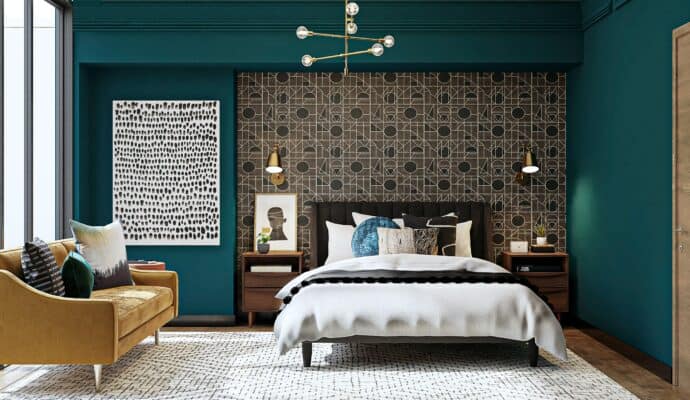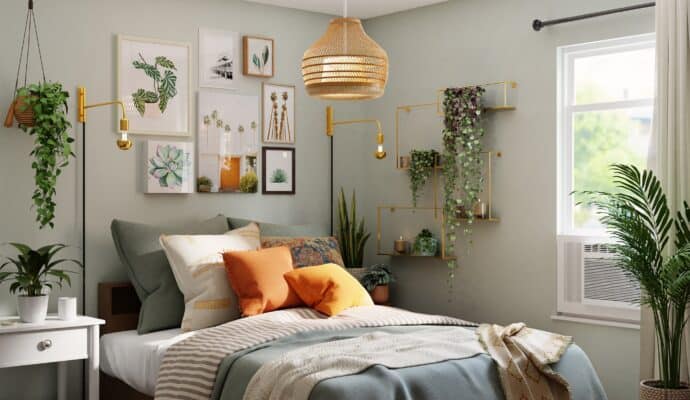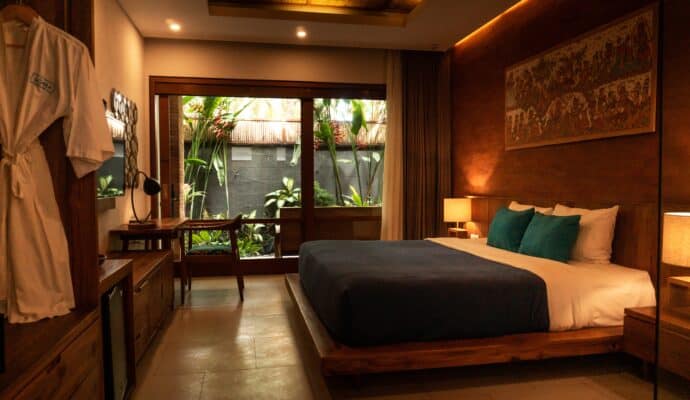It’s common knowledge that our surroundings can influence our mood. This is especially useful at work, for example, if you want to increase your productivity at the office. This, however, is something you can do at home as well when it comes to bedroom design and well-being.
After all, your home is supposed to be your peaceful oasis. Researchers have found that certain colors of bedroom walls are more beneficial to sleep. Keep in mind that decision-making abilities, long and short-term health, memory, and immunity all correlate with the amount and quality of sleep.
So, it is crucial to decorate your bedroom in a way that looks good and makes you sleep better, and makes you happier. With that in mind, here are a few ideas to help you feel empowered and make your home look better than ever.

Bedroom Design and Well-Being: Bed is the Centerpiece
Take your time and find the perfect place for your bed. Pay attention to which way the primary window in your bedroom faces. Is your bedroom filled with bright morning light, or is it washed in soft afternoon light? Planning the appropriate shades, plants, paint colors, and furniture arrangements will be easier if you are aware of your natural light situation.
For instance, early morning sunlight may wake you up before your circadian rhythm is ready if your bed is next to an east-facing window. If it’s possible, turn the bed so it faces a different direction; if not, consider buying blackout curtains.
It might be time to evaluate your bedroom furniture if you haven’t touched it in a while, especially in terms of the quality of your mattress. Put that at the top of your remodeling priorities. If you need help choosing the right one for your needs click here to see what are the possibilities. It is critical to understand how to select a mattress that will provide comfort for many years to come.
Bedroom Design and Well-Being: Stick to a Soothing Color Theme
Be aware that there is no such thing as a one-size-fits-all relaxing bedroom wall color. Any color that makes you feel calm and comfortable will lead to better sleep. If a neutral color scheme helps you relax, mix it into the décor of your room. If you want to create a space that looks like it’s at night, use dark and moody paint colors.
Yellow or red as primary components, such as orange and red — can also be calming. But be careful with warm colors; they may not be ideal for someone looking to sleep better at night. For example, it is known that the yellow color may provide people with energy in many cases. However, choose a paint color that relaxes you, whether it’s a soothing neutral or a rich, deep tone. Nobody can say what works best for you other than you.

Bedroom Design and Well-Being: Bring the Garden Inside
Vertical gardens are a popular trend right now especially if you lack space. This is mostly due to limited space in urban areas and rising health and wellness awareness. Gardens and parks have been linked to both physical and mental health as you know. The presence of plants has been proven to help people to manage stress and reclaim inner peace.
Like people, plants function best at an ideal temperature. Study says that temperature is one of the most influential factors in getting high-quality sleep. Whether you want to keep your plant alive or optimize your sleeping space, you can now do both. Crack a window for fresh air, or turn down the thermostat.
Bedroom Design and Well-Being: Reduce Artificial Lighting
It is proven that exposure to artificial light is harmful to human health. The presence of depressive disorders is increasing, and this trend is related to how much nighttime lighting is used in modern society. Keep the number of lamps and bulbs in your bedroom to a minimum to lower your risk of depression.
Because of the way our bodies are built, we should sleep at night to maintain good health. Keep your bedroom dark while you are sleeping. Train yourself to sleep with no light at all. This also goes for the screen light, the same rule applies to teenagers and screen time. Just like you have trained your mind and body to fall asleep to the faint light of a night lamp, or the light or sound from a TV.

Bedroom Design and Well-Being: If Isn’t Working Change It
If you’ve managed to create a dark, quiet, cool room but still aren’t getting any quality rest, change it. Take your time considering how each change affects your sleep.
It takes time to design a bedroom that promotes rest. It doesn’t have to feel perfect right away. You might need to rearrange your bedroom a few times or experiment as seasons change, but in the end, you’ll find the ideal balance and your bedroom will feel like the perfect place to fall asleep.
About the Author
Victoria Lim is a lifestyle writer with expertise in scribbling a lot of words, traveling with a big pack of gummy bears (green ones to the victory!), walking a dog for miles and miles, and choosing a tea for her next cup.
